Looking for ways to ignite your child’s curiosity and spark a love of science? Look no further! This guide is packed with exciting science experiments for kids that are both fun and easy experiments for kids and they are kid friendly science experiments . Whether you’re at home or in the classroom, these engaging activities will transform playtime into a thrilling exploration of the world around them.
From classic favorites like the erupting volcano experiment powered by baking soda and vinegar, to fascinating discoveries about density and buoyancy, these experiments use everyday household items to create extraordinary learning experiences. Get ready to witness fizzing reactions, explore invisible forces, and unlock the secrets of the natural world – all through the power of learning through play.
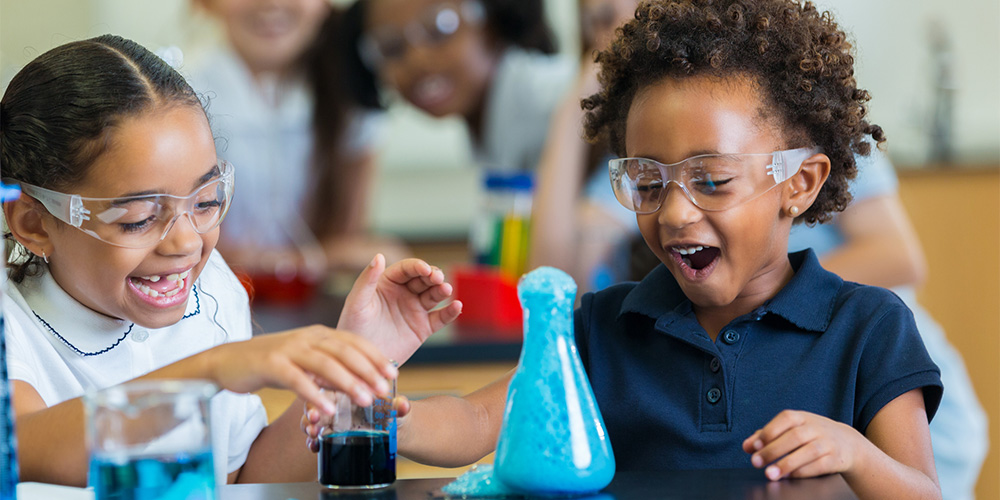
5 Science experiments for kids at home:
Here are a few ideas of science experiments for kids at home which you easily do and they are kid friendly science experiments and its own dedicated section for clear explanation:
1. Volcano Experiment: A Fun Science Exploration for Kids:
The classic baking soda and vinegar volcano is a favorite for a reason! It’s a simple and exciting experiment that demonstrates a natural science phenomenon – chemical reactions. This experiment lets kids see how combining an acid (vinegar) and a base (baking soda) creates a fizzy eruption, mimicking a real volcano. It’s a great introduction to exciting scientific concepts!
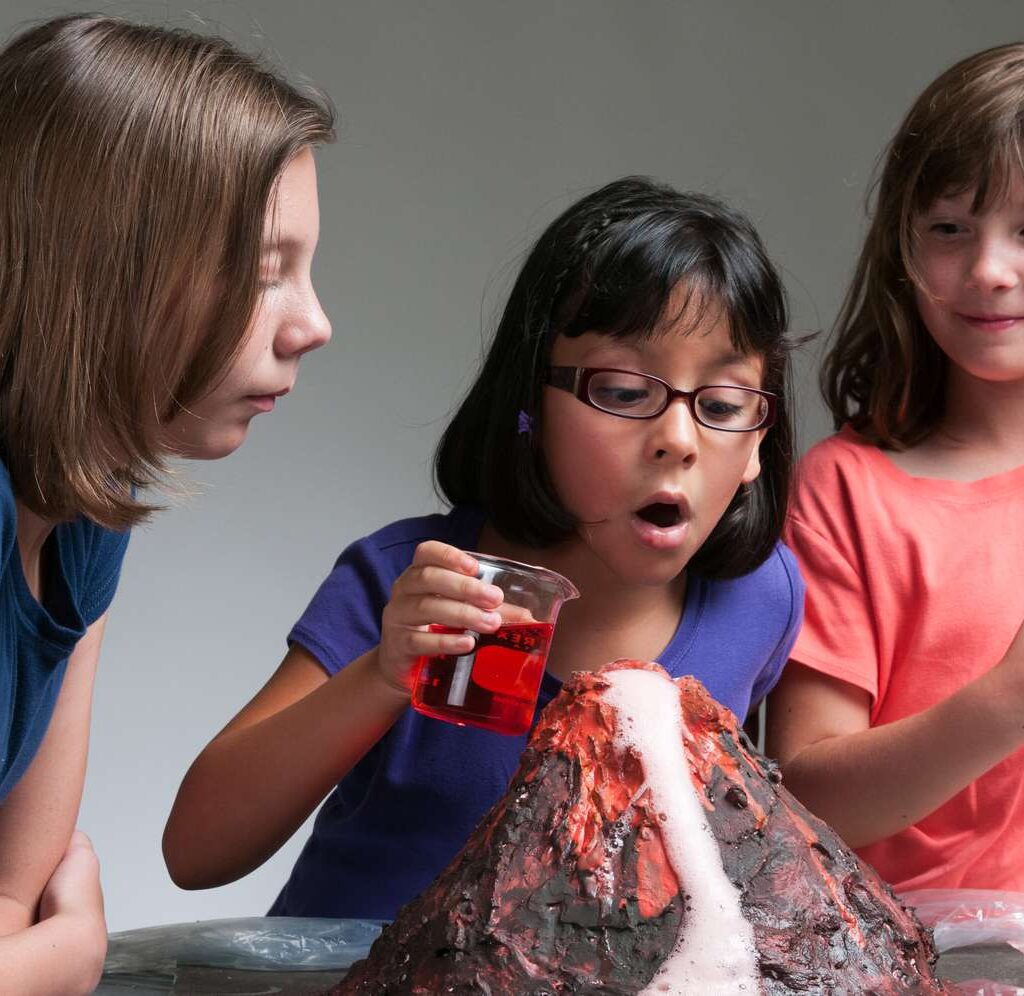
Materials You’ll Need:
- sodium bicarbonate
- acetic acid
- Dish soap
- Baking sheet or tray
- construction paper (optional, to decorate your volcano)
Instructions:
- Build your volcano: Use construction paper or mold play dough into a cone shape for a classic volcano look
- Filler up: Pour a generous amount of baking soda into the volcano’s crater
- Eruption time! :Carefully add a small amount of acetic acid to the sodium bicarbonate, watch an amazement as the mixture fizzes and erupts.
Scientific Explanation:
This erupting favorite showcases a classic acid-base reaction. Sodium bicarbonate (baking soda) is a base, while acetic acid (vinegar) is an acid. When combined, they react rapidly, releasing carbon dioxide gas (the fizzing foam) and water vapor, propelling the colorful solution out of the volcano crater.
2. Fizzing Balloons:
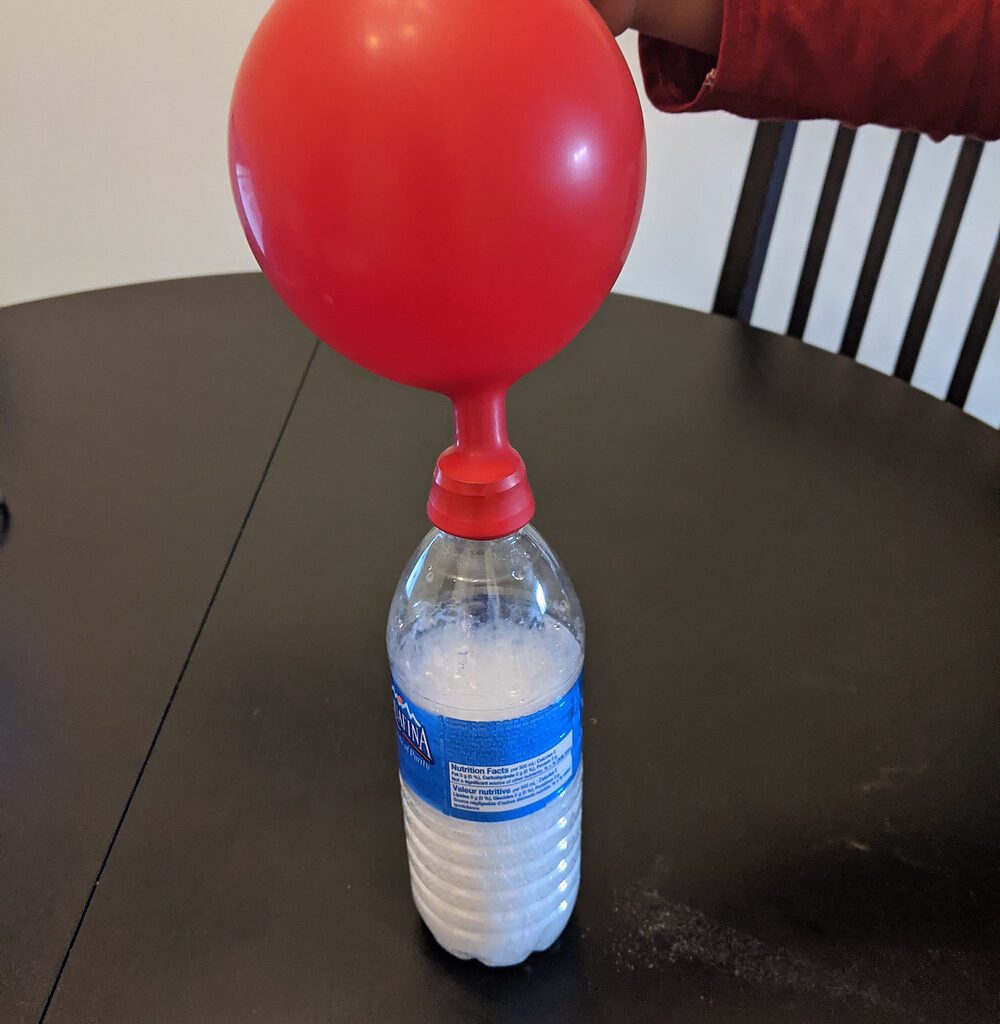
Materials:
- sodium bicarbonate
- acetic acid
- balloon
- water(optional)
- funnel and bottle
Instructions:
- Fill Balloon: Fill a balloon with sodium bicarbonate using a funnel
- Mixer: In a separate container, mix acetic acid with a little water (dilute the vinegar for a less intense reaction, optional).
- Pour Acetic acid: Carefully pour the vinegar solution into the bottle and watch the balloon inflate with fizzy gas
Scientific Explanation:
this activity features a captivating acid-base reaction. The sodium bicarbonate in the balloon reacts with the acetic acid solution, generating carbon dioxide gas. The gas inflates the balloon as it has nowhere else to go, demonstrating the pressure created during the reaction.
3. Rainbow Reaction :
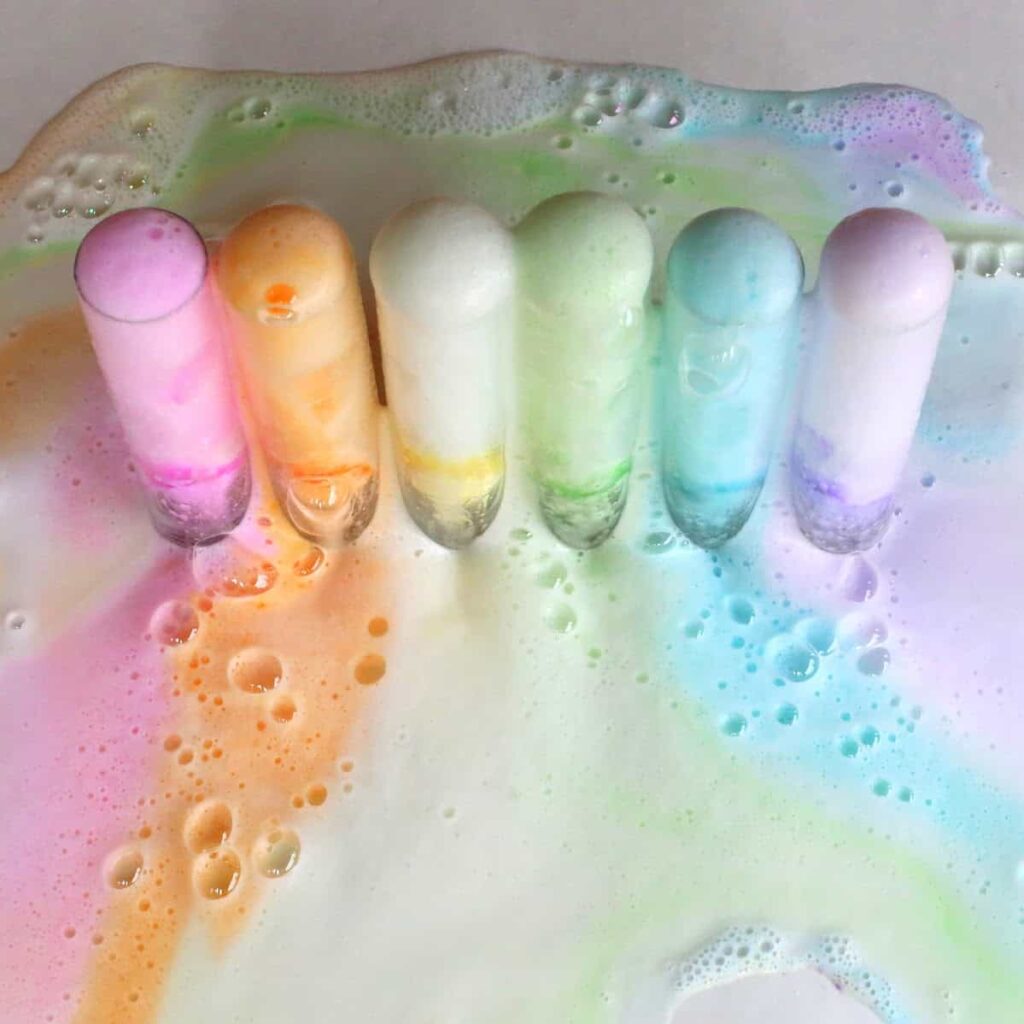
Materials:
- Sodium bicarbonate
- Acetic acid
- Food coloring
- Tray
Instructions:
- Food coloring: Add drops of food coloring to sodium bicarbonate spread on a tray
- Fizzing colors: Drop acetic acid onto the colored baking soda and observed the vibrant fizzing colors explosions!
Scientific Explanation:
This vibrant experiment combines the acid-base reaction with the science of color. The baking soda provides a base, while the food coloring adds pops of color. When acetic acid is added, the reaction produces carbon dioxide gas and breaks down the food coloring into its individual components, creating a mesmerizing fizzing display of colors.
4. Fizzing Boats:
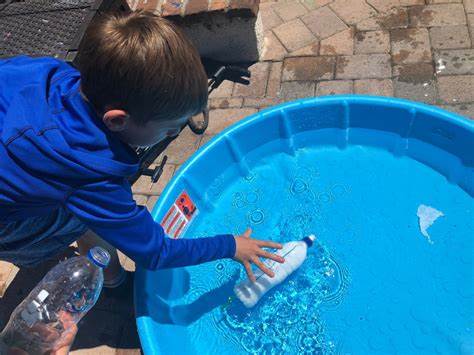
Materials:
- Small Papers boat
- Acetic acid
- shallow dish of water
Instructions:
- Paper boat: Float small paper boats in a shallow dish of water
- Fizzing colors: Add drops of sodium bicarbonate near the boats and watch them propel themselves forward with the fizzing reactions!
Scientific Explanation:
This self-propelling boat race utilizes the same scientific principle as the previous experiments. The sodium bicarbonate on the tray reacts with the acetic acid, generating carbon dioxide gas. Since the reaction occurs near the boats, the released gas propels them forward in the water, mimicking a miniature jet engine.
5. The Eggcellent Race:
This experiment demonstrates the concept of density, the mass of an object per unit volume. Eggs will sink or float depending on the density of the liquid they are placed in.

Materials:
- Two large glasses or clear containers
- Tap water
- Salt
- Two raw eggs (one per solution)
- Spoon for stirring Marker (optional)
Instructions:
- Label one glass “Tap Water” and the other “Saltwater.”
- Fill the “Tap Water” glass with tap water.
- Fill the “Saltwater” glass about ¾ full with tap water.
- Add about 4-5 tablespoons of salt to the “Saltwater” glass. Stir until the salt dissolves completely. You can taste a drop to see if there’s any undissolved salt remaining.
- (Optional) Use a marker to draw a waterline on both glasses to indicate the initial water level before adding the eggs.
- Carefully place one egg in each glass. Observe what happens.
Scientific Explanation:
This experiment explores the concept of density. Density refers to the mass of an object per unit volume. Eggs have a higher density than tap water, causing them to sink. However, salt water creates a denser solution due to the dissolved salt particles. When placed in saltwater, the egg experiences an upward buoyant force that counteracts gravity, making it float. The denser saltwater allows the egg to overcome its weight and achieve a state of buoyancy.
5 Science Experiments for kids at school:
Here are a few ideas of science experiments for kids at home which you easily do with its own dedicated section for clear explanation:
1. Rainbow in a Jar
Materials You Will Need:
- A clear glass or jar
- Water
- Flashlight
- White paper
Instructions:
- Fill the clear glass or jar with tap water.
- Dim the classroom lights or conduct the experiment in a low-light area.
- Position the flashlight outside the jar on one side.
- Shine the flashlight beam horizontally through the water, aiming it towards the opposite side of the jar.
- Place the white paper directly behind the jar, opposite the flashlight beam.
- Observe the appearance of a rainbow on the white paper!
Scientific Explanation:
Light travels in waves, and each color wavelength bends slightly differently when it passes through water (or any other transparent medium). This bending of light separates the visible light spectrum into its individual colors, creating the rainbow effect.
2. Paper Chromatography:
Materials You Will Need:
- Coffee filters
- Markers (black or colorful work best)
- Tape
- Two shallow dishes (such as petri dishes or trays)
- Water
Instructions:
- Draw a small dot or line near the bottom edge of a coffee filter using a marker.
- Fill one of the shallow dishes with a thin layer of water (enough to cover the bottom but not deep enough to submerge the coffee filter completely).
- Carefully tape the coffee filter to the rim of the dish, with the marked side facing down and the dot or line dipping slightly into the water.
- Observe the coffee filter as the water travels up the paper. Notice how the colors from the marker separate as the solvent (water) moves through the coffee filter.
Scientific Explanation:
Paper chromatography separates mixtures based on the polarity of their components. More polar molecules interact more strongly with the water solvent and travel slower up the filter paper. Less polar molecules interact less with the water and travel faster. The separation of colors in the marker ink demonstrates this principle.
3. Plant Respiration:
Materials You Will Need:
- Two identical jars
- Alka-Seltzer tablets (one per jar)
- Baker’s yeast (one packet)
- Warm water
- Sugar (1 tablespoon)
- Balloons
- Masking tape
Instructions:
- Fill one jar with water and drop in a crushed Alka-Seltzer tablet. This will serve as the control experiment.
- In the other jar, mix warm water, sugar, and the packet of yeast. Let the mixture sit for a few minutes until it becomes foamy.
- Stretch a balloon over the mouth of each jar and secure it tightly with masking tape.
- Observe both jars over time. Notice how the balloon over the yeast mixture inflates much faster than the one over the Alka-Seltzer solution.
Scientific Explanation:
Plants, including yeast, undergo cellular respiration, a process that breaks down sugar molecules to release energy. During respiration, they take in oxygen and release carbon dioxide. The inflated balloon over the yeast mixture indicates the production of carbon dioxide gas from respiration. The control jar with the Alka-Seltzer tablet helps demonstrate that the inflation in the yeast jar is not simply due to the container being sealed.
4. Static Electricity:
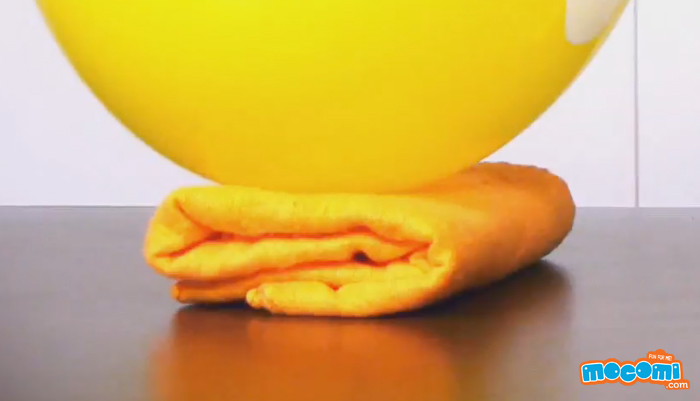
Materials You Will Need:
- Balloon
- Woolen cloth
- Small pieces of paper or Styrofoam
Instructions:
- Inflate the balloon.
- Rub the balloon vigorously against the woolen cloth for several seconds.
- Hold the charged balloon near the small paper or Styrofoam pieces. Observe how they are attracted to the balloon.
- Now, rub the balloon repeatedly against your hair (or another source of friction) and hold it near the attracted pieces again. Notice how they are now repelled by the balloon.
Scientific Explanation:
Rubbing the balloon against the cloth transfers electrons to the balloon’s surface, giving it a negative charge. Opposite charges attract, so the positively charged paper or Styrofoam pieces are initially drawn to the negatively charged balloon. Further rubbing against hair can transfer additional electrons, making the balloon even more negatively charged. Like charges repel each other, hence the observed repulsion of the paper or Styrofoam after additional rubbing.
5. Capillary Action:

Materials:
- Glass or cup
- Water
- Food coloring (a few drops, optional)
- Celery stalks
Instructions:
- Prepare the Water: Fill the glass or cup with tap water. If desired, add a few drops of food coloring to the water. This will help visualize the movement of the water more easily.
- Cut the Celery: Select two or three celery stalks of similar size. Using a sharp knife, cut them into equal lengths, approximately 4-5 inches each.
- Observe the Starting Point: Take a moment to observe the cut ends of the celery stalks. Notice any visible pores or channels in the cross-section.
- Stand the Celery Upright: Place the celery stalks upright in the glass of water. Ensure the cut ends of the stalks are completely submerged in the water.
- Track the Water Movement: Observe the celery stalks over a period of time (around 15-30 minutes). You might notice tiny air bubbles escaping from the cut ends as water starts to fill the internal channels.
- Record Your Observations: Pay close attention to the following:
- Does the water level in the glass change noticeably?
- Can you see any visual changes in the color or translucency of the celery stalks?
- How high does the water appear to travel up the celery stalks over time?
Scientific Explanation:
Celery stalks have a network of tiny tubes called xylem vessels. These vessels transport water and nutrients throughout the plant. When the cut end of the celery stalk is placed in water, capillary action takes place. The water molecules are attracted to the walls of the xylem vessels (adhesion) and to each other (cohesion). This creates an upward force that draws the water up the narrow tubes against gravity.
Learning Through Play:
These sodium bicarbonate and acetic acid experiments are not just fun, they’re educational too! Here’s what your child can learn:
- Chemical Reactions: Witnessing the fizzing and bubbling firsthand helps children understand the concept of chemical reactions.
- Cause and Effect: Children can observe how adding acetic acid to sodium bicarbonate creates a specific reaction.
- Experimentation: Encourage your child to try different amounts of sodium bicarbonate and vinegar to see how it affects the eruption.
Safety Tips:
Remember, adult supervision is essential when conducting science experiments with young children. Here are some safety tips to keep in mind:
- Wear protective clothing, like an apron, to avoid spills.
- Use plastic containers for safety.
- Start with small amounts of acetic acid and gradually add more for a controlled reaction.
FAQS:
Q:What are some fun and engaging kid friendly science experiments we can do at home?
The world of science is filled with wonder, and these kid-friendly science experiments are the perfect way to introduce your child to amazing discoveries. They utilize common household items and simple instructions, making them accessible and exciting for young minds. From erupting volcanoes powered by baking soda and vinegar to captivating explorations of density and buoyancy using eggs, these activities will transform playtime into a thrilling scientific exploration.
Q: What are some easy and engaging science experiments I can do with my kids at home?
A: There are countless exciting science experiments for kids that utilize common household items! Here are a few ideas to get you started:
- Fizzing Volcano: Witness a classic chemical reaction with the baking soda and vinegar volcano! This erupting favorite demonstrates the power of acids and bases in a captivating way. (Science Experiments for Kids with Baking Soda and Vinegar)
- Dancing Raisins: Explore density with a fizzy raisin race! Drop raisins into club soda and observe their buoyancy as the carbon dioxide bubbles lift them. Science is all around us, even in a simple glass of bubbly water! (Science Experiments for Kids with Water)
- Rainbow in a Glass: Unleash the beauty of color separation with a stunning rainbow in a cup experiment! Layer water with food coloring to create a mesmerizing display of density and color. (Science Experiments for Kids with Water and Food Coloring)
Q: Looking for engaging science experiments suitable for a classroom setting?
A: Absolutely! Science experiments for kids at school are a fantastic way to bring science concepts to life in a captivating and interactive way. Here’s an example that utilizes readily available materials:
- The Eggcellent Race: Explore density with a fun egg float or sink experiment! Divide students into groups and provide them with eggs, water, and salt. Each group can create saltwater solutions of varying concentrations and observe how they affect the buoyancy of the eggs. This simple activity promotes teamwork and helps students understand the relationship between density, mass, and volume.
Q: What are some interesting science experiments I can do in high school?
A: There are many fascinating science experiments you can conduct in high school, depending on your area of interest! Here’s one exciting option to get you started:
Osmosis with Potato Slices: This experiment explores the concept of osmosis, the movement of water across a semi-permeable membrane. By placing potato slices in solutions of varying concentrations, you can observe how water moves in and out of the cells, causing the potato slices to shrink or swell. This is a great introduction to cell biology and the importance of osmosis in living organisms.
For further experiment ideas and resources, you can explore websites like Science Buddies (https://www.sciencebuddies.org/) or search for specific experiments related to biology, chemistry, physics, or environmental science.
Conclusion:
By incorporating these fun science experiments for kids into your child’s routine, you’re not just creating memorable moments, you’re nurturing a lifelong love of science. These hands-on activities encourage critical thinking, problem-solving skills, and a sense of wonder for the amazing world around us. So, grab your lab coats (or kitchen aprons!), gather your supplies, and get ready to embark on a scientific adventure with your little learners! Happy experimenting!
External Resources:
Educational websites:
https://stevespangler.com/experiments
https://kids.nationalgeographic.com
Books:
Kitchen science lab for kids: 52 fun experiments to explore the amazing world of science

Empowering parents to raise happy, confident kids. Get practical parenting tips and advice on our blog, Smart Parent Guides.
